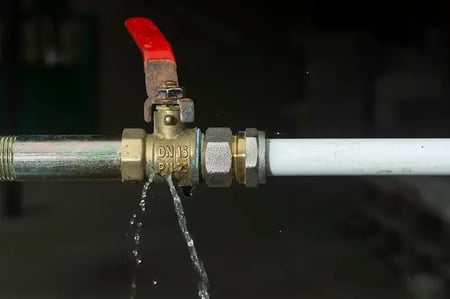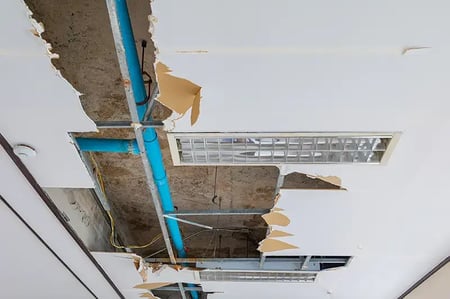Detecting Water Riser Leaks
When water risers leak in commercial and industrial buildings, it quickly escalates from a small inconvenience to catastrophic and expensive water loss.
Discover why leaks commonly occur in water risers, the damage they cause, and key attributes of water leak detection solutions that offer effective detection.
What causes leaks in water risers?
-
The most common causes of leaks from water risers occur in the pipes:
-
Cracks and damage from general wear and tear, including stresses from thermal conditions, corrosion, and vibrations.
-
Clogs and hard water buildup.
-
Loose seals and/ or worn out connections between the main, branch, and individual risers; and risers and outlets.
-
-
Water risers in harsher industrial environments or that are subject to heavier use experience greater wear and tear, and develop leaks more quickly. For example:
-
Factories with high levels of vibration.
-
Buildings that experience extreme interior temperatures.
-
High-density multifamily residential buildings.

Where do water riser leaks occur?
Leaks from water risers can occur almost anywhere in a building.
In riser rooms & cupboards
If you're lucky, you might see a water leak in a riser room or cupboard. These areas offer easier access for repair and maintenance - but contain a small proportion of the overall riser system.
However, noticing leaks in these areas typically relies on manual inspections from your facilities management team, who visually inspect the areas and equipment on some sort of schedule. If a leak is small or doesn't coincide with the inspection schedule, you may miss it until greater visible damage is done.
Inside interior walls, ceilings, & floors
The vast majority of the water riser pipework is located inside walls, ceilings, and floors. It's typically concealed by drywall, without the convenience of access panels. And it's here that the majority of water riser leaks occur.
This concealed and inaccessible location makes it impossible to visually detect smaller leaks. You'll typically notice the leaks once visible damage is done - anything from dripping, to visible water staining, or significant escape of water.

What happens when a water riser leaks?
Water escapes
Depending on the type of water riser, pipe diameter, water pressure, and nature of the damage, any of the following scenarios are possible:
- A small crack in an individual riser (as opposed to a branch or main riser) might cause a very small leak that drips. Water will pool on flat surfaces like floors, and will run down vertical surfaces.
- A small crack in a branch riser - with greater pipe diameter and water pressure - will see water escape with more force. It might spray surrounding areas, or leak water in a steady stream.
- A small crack in a main riser may result in water exiting the riser pipe with significant force, spraying the surrounding areas. The pressure might further weaken the crack, resulting in increased water loss and potential escalation to a catastrophic leak.

Damage occurs
As the water escapes:
- Whatever can't pool on a horizontal surface will travel downwards, allowing the water to travel down between floors.
- Porous materials, including fiberglass insulation, will soak the water up, potentially damaging them.
- Drywall may swell and buckle. Once soaked, it will show visible staining.
- Water may pool at the bottom of cabinets and floors, potentially soaking through to ceilings below.
- In some cases, water may enter electrical outlets and cause them to short.

Damage escalates
If the leak is in a concealed location, it’s less likely to be discovered, causing further damage:
- Areas that remain damp will start to grow mold and mildew, which can impact air quality and tenant health.
- If the leak is from a waste pipe, a smell will quickly develop. Bacteria will grow. Tenants will be exposed to a range of additional potential health hazards.
- A leak that is sufficiently large, remains undetected for a long period of time, or recurs often, may do significant structural damage to the fabric of the building.

Water riser leaks are poorly served by traditional water leak detectors
Older water leak detectors like pucks and flow meters offer inadequate detection for leaks in water risers
-
Pucks have a very small sensing area to detect water leaks, which means each device provides limited coverage. A significant amount of water may need to pool in order for a puck to detect the leak, potentially causing more damage. And when vertical space is at a premium, even small pucks may be too large to be placed directly under water riser pipes.
-
Rope sensors are prone to high false positive rates due to dust - a real challenge for the riser use case, as the pipes are typically in very dusty environments. They're already challenging to fix in place even on clean, flat surfaces; so fixing them in place on dusty, unfinished surfaces makes installation a real burden.
-
Flow meters can provide data that demonstrates changes in water flow rates, but they take a long time to detect anomalies. They also fail to detect smaller leaks, or to pinpoint the specific location in the riser network where water is pooling.

To successfully detect leaks from water risers, a water leak detection solution needs comprehensive capabilities
-
To provide facilities managers with accurate information on the leak and its location, so that they can prioritize its repair according to urgency and potential damage.
-
To be able to detect a leak early enough to avoid significant downtime and damage, without causing false positives.
-
To provide aggregated data to facilitate improved decision-making across fixtures, floors, and facilities.
-
To be easy to install where there are space constraints.
- To not require maintenance once installed, particularly when in inaccessible locations.
How LAIIER’s Severn WLD detects riser water leaks
Severn WLD™ detects leaks throughout the water riser infrastructure in commercial and industrial settings
- Facilities managers receive emergency leak alerts that identify the specific location where water is pooling. Further data can be reviewed to determine leak size and growth, making it easier to prioritize repairs.
- Its small size and trimmable sensor means Severn WLD easily fits into tight spaces under water riser pipes: both in walls and floors, and in riser rooms and cupboards.
- With tool-free, self-adhesive installation, each device remains in place until you decide to move it. Its robustness and IP65 rating make it suitable for use in even in rugged industrial environments; and a 6-year battery life means it's maintenance-free.
- Water leaks can be detected early, before significant damage occurs and is visible.
- The same water leak detection device serves multiple use cases in the same buildings, including detecting water leaks from sanitaryware, plant rooms, HVAC, appliances, and industrial equipment.
Explore the benefits of early water leak detection
Book a call with our team for a confidential discussion about detecting leaks in your water risers.
